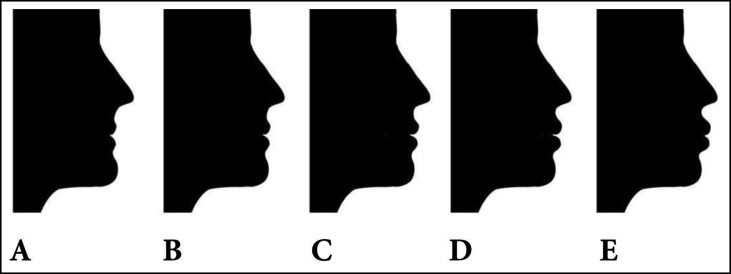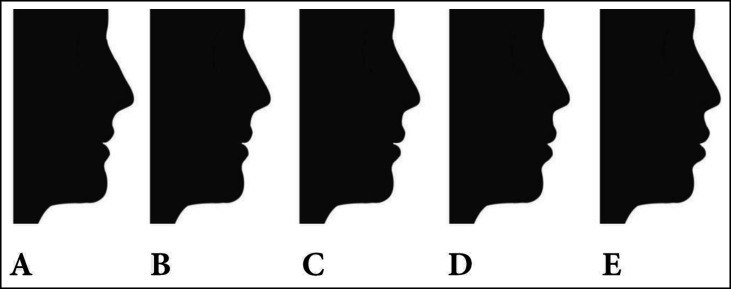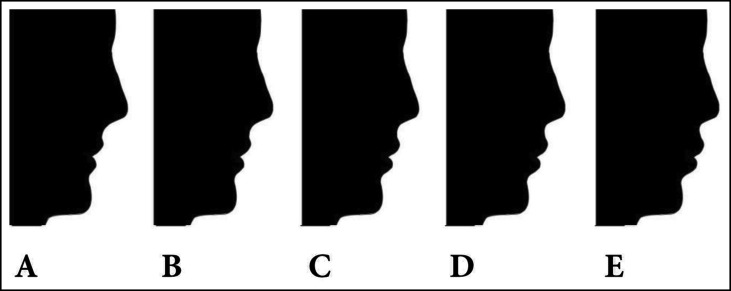Introduction
The aim of this study was to determine the preferred lip position in silhouette profiles with different amounts of divergence.
Methods
A normal profile was constructed based on normal values and was altered using software (Photoshop CS, version 8.0; Adobe Systems, San Jose, Calif) to produce a series of 15 profiles in 3 sets (straight, anterior, and posterior divergent). Each set consisted of 5 photographs with different lip positions from −4 mm to +4 mm in 2-mm increments. We asked 240 people in 5 panels (79 senior dental students, 26 orthodontists, 27 maxillofacial surgeons, 27 prosthodontists, and 81 laypeople) to rate the profiles. Mann-Whitney and Kruskal-Wallis tests, and intraclass correlation coefficients were used to analyze the data.
Results
In the anterior and posterior divergent profiles, most groups tended to prefer the original lip positions for both the male and female profiles. In the straight divergent profile, the results were scattered and inconsistent in the different groups. In the posterior divergent profile, the orthodontists and the surgeons selected the 4-mm lip retrusion as the least attractive, and other groups selected the 4-mm lip protrusion as the least attractive. In the anterior and straight divergent profiles, all groups were unanimous in the selection of the 4-mm lip protrusion as the least attractive images. Significant differences were found between the raters in the rankings of some images. No significant difference was found between the male and female raters in the rankings of the profile images.
Conclusions
It is important to establish a normal lip position, especially for a patient with an anterior or a posterior divergent profile. Posterior divergent patients should be treated cautiously so that excessive lip retrusion does not result.
Highlights
- •
In anterior and posterior divergent profiles, raters tended to prefer the original lip position.
- •
In the straight divergent profile, the results were scattered and inconsistent.
- •
Significant differences were found between the raters in the rankings of some images.
- •
No significant difference was found between male and female raters in the ranking of the profile images.
Nowadays, a strong focus has been placed on facial beauty and attractiveness. Improvement in facial esthetics is a main reason that patients seek orthodontic treatment; in recent years, it has become even more important for both patients and orthodontists. Although orthodontic diagnosis is carried out in 3 dimensions (transverse, anteroposterior, and vertical), much of the emphasis in treatment planning is placed on the esthetics of the face in profile. The lower third of the face from the base of the nose to soft tissue menton is an integral part of orthodontic diagnosis and treatment planning. The importance of soft tissue profile analysis in orthodontic treatment planning has been demonstrated. The lip posture has also been defined as a crucial element in overall facial esthetics, posttreatment stability, and function. It has been suggested that a well-balanced relationship between the lips, chin, and nose is required to obtain optimum facial harmony and esthetics.
Several studies have been conducted to evaluate the effect of lip position on esthetic preferences. Yehezkel and Turley concluded that with a change in the esthetic standards for the African American female profile during the 20th century, the public has gravitated toward fuller and more anteriorly positioned lips. It has been proved that facial convexity may affect the preferred lip position. Ioi et al found that with a decrease in the facial convexity, more retruded lip positions were favored. In another study, it was reported that in extremely retrognathic and prognathic subjects, fuller lip positions were preferred, whereas more retrusive lip positions were preferred for more average profiles. Modarai et al stated that the mandibular position plays an important part in the ideal position of the lower lip. One factor that can be evaluated in the profile view is facial divergence. Divergence of the face (the term was first used by the orthodontist-anthropologist Milo Hellman) is defined as “an anterior or posterior inclination of the lower face relative to the forehead” and is affected by the patient’s racial and ethnic background. A straight profile line, regardless of its divergence, does not indicate a problem, but convexity or concavity does. Although authors of previous studies have evaluated the preferred lip position in various facial profiles, to the best of our knowledge, no authors have evaluated the preferred lip position with different amounts of facial divergence. Moreover, because the facial divergence is a characteristic of the patient’s inherent underlying skeletal pattern and does not indicate a problem, the orthodontist or the patient does not wish to change it. Therefore, understanding the preferred lip position with regard to the type of facial divergence can facilitate treatment planning and decision making to obtain the most attractive facial profile upon the completion of orthodontic treatment.
The objective of this study was to develop a series of facial profiles based on the original ideal constructed profile for evaluation by the members of various dental professions and laypeople. By varying the facial divergence and the lip position, we hoped to determine the most and the least desirable combinations and to elucidate whether the rater’s profession and sex affect the preference.
Material and methods
An ideal profile image in natural head position was constructed according to the method of Jacobson with computer software (Photoshop CS, version 8.0; Adobe Systems, San Jose, Calif) with the following parameters taken into account: Vertical proportion in profile view, angle of facial convexity, nasofacial angle, nasomental angle, mentocervical angle, submental-neck angle, nasolabial angle, upper and lower lips and chin prominence in relation to SnV, upper and lower lips prominence to Sn-Pog′, 0° meridian, lips to E-line, lips to S-line, facial angle, and upper lip curvature. Two-dimensional facial profile silhouettes were used to assess the perceptions of facial profile attractiveness. The facial silhouettes were constructed in black to prevent the effect of distracters. The profile was changed to an androgynous silhouette by removing the hair to reduce the influence of sex-defining features.
While maintaining the normal profile convexity, the profile divergence was altered with the Photoshop software, by changing the position of subnasale and soft tissue pogonion horizontally relative to the true vertical line that crosses glabella to create 3 forms of normal profile : anterior divergent (glabella-Sn to true vertical line, +15°, and glabella-Pog′ to true vertical line, +10°); straight divergent (glabella-Sn to true vertical line, +5°, and glabella-Pog′ to true vertical line, 0°); and posterior divergent (glabella-Sn to true vertical line, −5°, and glabella-Pog′ to true vertical line, −10°). To focus on the sagittal aspects of the facial profile, the vertical height of the constructed profile was not changed ( Table I ).
| Abbreviation | Definition |
|---|---|
| Sn | The point at which the columella (nasal septum) merges with the upper lip in the midsagittal plane |
| Pog’ | The most prominent or anterior point on the chin in the midsagittal plane |
| Glabella | The most prominent anterior point in the midsagittal plane of the forehead |
For each facial divergence, a series of 5 profiles was developed to represent different lip protrusions (A, B, C, D, and E). The profile with average lip protrusion relative to E-line, S-line, and SnV was placed in the middle of each series (picture C). The lips were then protruded or retruded in 2-mm increments for different lip protrusions or retrusions. Therefore, an 8-mm difference existed between the most retruded profile (picture A, −4 mm) and the most protruded profile (picture E, +4 mm) in each series. The increments or decrements in the positions of the lips were made in a consistent manner in the sagittal plane. The result was 15 photographs (in 3 series) with combinations of different amounts of facial divergence and lip protrusion.
The profiles were presented separately in 3 sets (straight, anterior divergent, and posterior divergent), and each set had 5 photographs with different degrees of lip protrusion ( Figs 1-3 ).



The panel of raters included 240 people: 79 senior dental students enrolled in dental school at the Shiraz University of Medical Sciences; 26 orthodontists; 27 maxillofacial surgeons; and 27 prosthodontists who were either in the faculty practice at Shiraz Dental School or had a private practice in Shiraz; and 81 patients, selected by simple randomization from those referred to Shiraz Dental School for treatment, who were called laypeople. The inclusion criteria for the laypeople were 18 years of age or older, no history of orthodontic or facial surgical treatment, no facial deformities, no facial trauma, and not health care employees. A questionnaire was prepared for rating the profiles based on a Likert type of rating scale.
The Likert scale is largely accepted in the psychology literature as the most useful rating method. All raters were asked to evaluate the profile series of each set in 1 session and score them from 1 to 5: 1, very unattractive; 2, unattractive; 3, neither attractive nor unattractive; 4, attractive; or 5, very attractive. They were asked not to assign the same score to more than 1 profile and to score 1 for the least attractive and 5 for the most attractive silhouette. Some questions regarding the demographic characteristics of the raters (age, sex, and profession) were also included in the questionnaire. The evaluators were asked to grade the profiles separately for the sexes to record whether their perceptions of facial balance include sex bias for facial profiles.
During the rating process, each rater was seated in a quiet area apart from the other raters and given 10 minutes to complete the questionnaires. All questionnaires were filled out anonymously and marked with numeric codes. To determine the reliability of the results, 20% of the evaluators in each group were asked to complete the questionnaires again after 2 weeks.
Statistical analysis
After gathering the data, we performed the statistical analysis using SPSS software (version 19; IBM, Armonk, NY). The means and standard deviations for the rank scores were calculated for all images. Additionally, the means and standard deviations for the rank scores were calculated independently for each sex and group. The Kruskal-Wallis test was used to compare the rankings of the images among the 5 professional groups. The Mann-Whitney test was used to compare the scores of the male and female raters and for pair-wise comparisons in the professional groups. The Mann-Whitney test was also used to compare the scores of the male and female raters for all images. Reproducibility among scores between the 2 evaluations was tested using intraclass correlation coefficients (ICCs) with a 95% confidence interval.
Results
Overall, 240 evaluators—124 women (mean age, 29.20 ± 7.26 years) and 116 men (mean age, 30.62 ± 7.79 years)—participated in the study ( P >0.05). No significant difference was found between the male and female raters in the rankings of the profile images ( P >0.05). The means and standard deviations of the scores for the male and female profiles as ranked by the groups in each series are shown Tables II and III . No significant differences were found between the mean scores of the male and female profiles among raters except for the anterior divergent profile with a 4-mm lip retrusion (male raters, 2.59 ± 1.25; female raters, 2.31 ± 1.24; P <0.001) and the anterior divergent profile with a 2-mm lip protrusion (male raters, 2.99 ± 1.07; female raters, 3.16 ± 1.04; P = 0.028).
| Profile picture | Students | Orthodontists | Surgeons | Prosthodontists | Laypeople | P value |
|---|---|---|---|---|---|---|
| S1mA | 2.51 ± 1.2 | 2.57 ± 1 | 2.37 ± 0.8 | 2.66 ± 1.1 | 2.71 ± 1.4 | 0.826 |
| S1mB | 3.82 ± 1.0 | 4.03 ± 0.9 | 3.85 ± 0.9 | 4 ± 1 | 3.56 ± 1.1 | 0.176 |
| S1mC | 4.07 ± 0.9 | 4.26 ± 0.8 | 4.29 ± 0.9 | 4.07 ± 0.9 | 4.12 ± 0.9 | 0.751 |
| S1mD | 3.01 ± 1.0 | 2.88 ± 0.9 | 3.29 ± 0.8 | 2.88 ± 1 | 2.93 ± 1.2 | 0.411 |
| S1mE | 1.56 ± 1.1 | 1.23 ± 0.6 | 1.18 ± 0.7 | 1.37 ± 0.8 | 1.65 ± 1 | 0.008 † |
| S2mA | 2.91 ± 1.4 | 3.26 ± 1.5 | 2.62 ± 1.4 | 3.29 ± 1.4 | 2.79 ± 1.4 | 0.303 |
| S2mB | 3.46 ± 1.1 | 3.69 ± 1.1 | 3.48 ± 0.9 | 3.96 ± 1.1 | 3.32 ± 1.1 | 0.098 |
| S2mC | 3.50 ± 1 | 3.57 ± 0.8 | 3.77 ± 1.2 | 3.37 ± 0.8 | 3.24 ± 1.2 | 0.291 |
| S2mD | 3.30 ± 1.3 | 2.92 ± 1.2 | 3.37 ± 1.3 | 2.96 ± 1.2 | 3.40 ± 1.2 | 0.264 |
| S2mE | 1.84 ± 1.3 | 1.53 ± 1.1 | 1.74 ± 1 | 1.40 ± 1 | 2.27 ± 1.5 | 0.020 ∗ |
| S3mA | 2.39 ± 1.4 | 2.07 ± 1.4 | 2.00 ± 1.3 | 2.14 ± 1.2 | 2.30 ± 1.3 | 0.595 |
| S3mB | 3.44 ± 1.1 | 2.92 ± 1.1 | 2.96 ± 1.2 | 3.25 ± 1.2 | 3.19 ± 1.1 | 0.221 |
| S3mC | 3.56 ± 1.1 | 3.84 ± 0.8 | 3.92 ± 0.9 | 4.29 ± 0.8 | 3.75 ± 1.1 | 0.049* |
| S3mD | 3.39 ± 1.1 | 3.53 ± 1.2 | 3.51 ± 1.1 | 3.25 ± 1 | 3.65 ± 1.2 | 0.413 |
| S3mE | 2.20 ± 1.4 | 2.53 ± 1.6 | 2.59 ± 1.5 | 2.03 ± 1.3 | 2.08 ± 1.2 | 0.368 |
| Profile picture | Students | Orthodontists | Surgeons | Prosthodontists | Laypeople | P value |
|---|---|---|---|---|---|---|
| S1fA | 2.20 ± 1.2 | 2.11 ± 1 | 2.07 ± 1 | 2.44 ± 1.1 | 2.53 ± 1.3 | 0.317 |
| S1fB | 3.63 ± 1.1 | 4 ± 0.9 | 3.44 ± 0.9 | 4 ± 0.73 | 3.81 ± 1 | 0.148 |
| S1fC | 4.26 ± 0.9 | 4.23 ± 0.9 | 4.44 ± 0.8 | 4.37 ± 1 | 3.93 ± 0.9 | 0.022 ∗ |
| S1fD | 3.16 ± 1 | 3.07 ± 0.8 | 3.51 ± 1 | 2.77 ± 0.8 | 3.19 ± 1.1 | 0.085 |
| S1fE | 1.73 ± 1 | 1.57 ± 1.1 | 1.51 ± 0.9 | 1.40 ± 0.9 | 1.51 ± 0.9 | 0.221 |
| S2fA | 3.10 ± 1.5 | 2.80 ± 1.3 | 2.25 ± 1.3 | 3.14 ± 1.5 | 2.92 ± 1.4 | 0.115 |
| S2fB | 3.46 ± 1.1 | 3.57 ± 1.1 | 3.11 ± 1 | 3.62 ± 1.1 | 3.22 ± 1.2 | 0.265 |
| S2fC | 3.46 ± 1.1 | 3.65 ± 1.1 | 3.96 ± 1.1 | 3.59 ± 0.9 | 3.32 ± 1.2 | 0.157 |
| S2fD | 3.21 ± 1.2 | 3.15 ± 1.4 | 3.77 ± 1.1 | 2.88 ± 1.1 | 3.67 ± 1.2 | 0.010 ∗ |
| S2fE | 1.69 ± 1.1 | 1.80 ± 1.2 | 1.88 ± 1.1 | 1.74 ± 1.4 | 1.85 ± 1.1 | 0.440 |
| S3fA | 2.37 ± 1.5 | 2.19 ± 1.4 | 1.55 ± 0.7 | 2.29 ± 1.3 | 2.67 ± 1.3 | 0.004 † |
| S3fB | 3.11 ± 1.2 | 3.11 ± 1.1 | 2.92 ± 1 | 3.55 ± 1.3 | 3.24 ± 1.3 | 0.397 |
| S3fC | 3.51 ± 1 | 3.73 ± 1 | 4.03 ± 1.2 | 3.88 ± 0.9 | 3.54 ± 1.2 | 0.113 |
| S3fD | 3.45 ± 1.1 | 3.61 ± 1.3 | 3.66 ± 1 | 3.22 ± 1.1 | 3.37 ± 1.2 | 0.577 |
| S3fE | 2.53 ± 1.6 | 2.34 ± 1.4 | 2.81 ± 1.4 | 1.92 ± 1.3 | 2.16 ± 1.4 | 0.083 |
Stay updated, free dental videos. Join our Telegram channel

VIDEdental - Online dental courses


